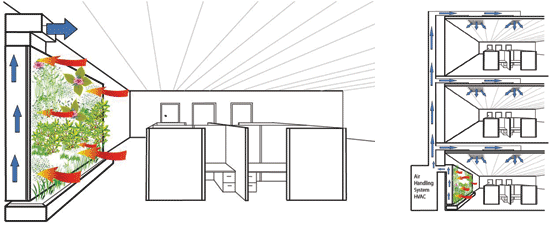Indoor Air Biofilters Deliver Clean Air Naturally
Indoor air biofilters also contribute to removal of particulate matter in the air. Commonly this is the role of filtration in HVAC systems which may use High-Efficiency Particulate Air (HEPA) filters rated to capture different sizes of airborne particles. They do nothing however, to control the gaseous chemicals in the air such as VOCs since they are specifically designed to trap particles. As these particles are collected, the filters get dirty and clog and need to be cleaned or replaced periodically, creating an ongoing maintenance and disposal requirement. By contrast, an indoor air biofilter uses the extensive surface of the plant material to significantly reduce airborne dust particles in addition to reducing chemical contaminants. This means that the system works very effectively as a total air “pre-filter” before the processed air enters or returns to the HVAC system. Dust particles collected in the biofilter are then washed away by the flowing water cascading down as part of the hydroponic process. This natural method of getting rid of contaminants means that the disposal issues are virtually eliminated.
 |
Indoor air biofilters can be readily integrated into a variety of vertical wall locations within a building. Photos courtesy of Nedlaw Living Walls Inc. |
The presence of an indoor air biofilter also creates an improved work environment that incorporates green plantings and the associated lighting that goes along with those plantings. Essentially, this brings the psychological benefits of nature to the indoor environment. Numerous studies have shown that people may first respond emotionally to this benefit, but scientific evidence supports real physical and psychological benefits from buildings that incorporate natural features and plant life. Buildings with biophilic-inspired elements have been demonstrated to provide psychological benefits to their occupants in a variety of ways. Studies show that workers in offices with views to nature tend to feel less frustrated, more patient, report higher levels of overall satisfaction and well-being, and are therefore more productive employees. These benefits coupled with the indoor air quality improvements lead to decreases in common office ailments (e.g., less fatigue and fewer headaches, sore throats, coughs, and dry skin issues), decreases in employee absenteeism, and typically increased employee productivity. One of the more difficult human resource challenges is actually not “absenteeism” but termed “presenteeism,” which is lost productivity as people mentally “check out.” An improved workplace with a varied environment and sensory stimulus allows for people to be happier, more relaxed, and stay “tuned in” longer. Since the cost of employees is a major line item in most companies' budgets, recognizing the correlation between indoor environmental quality, absenteeism, illness, and worker productivity is important. Some estimates put worker salaries at 35 to 40 percent of the typical company's budget such that even small investments in employee health, productivity, or employee retention can have enormous impacts on the overall profitability of the company.
 |
Indoor air biofilters can provide clean indoor air directly to an adjacent space or distribute it throughout the building’s HVAC system. Image courtesy of Nedlaw Living Walls Inc. |
Of course every green building is also concerned with the energy used to run the various building systems and here an indoor air biofilter can contribute significantly as well. Recent studies indicate biofilters are typically constructed to deliver 50 liters of “virtual outside air” per square meter of biofilter per second. This cleaned air can be integrated into the building in one of two ways. The first mode of operation is to keep ventilation rates the same and use the biofiltered air to augment what is being brought in from outside. Under this scenario, the occupants will enjoy a substantially higher IAQ since 30 percent reductions in airborne pollutants are expected, increasing the wellbeing of the occupants. There will be a small nominal increase in energy since the HVAC system will run normally while lights and water pumps associated with the biofilter will also need to run. The preferred, energy-efficient alternative mode of operation is to use the biofiltered air to actually replace the need for bringing in the full amount of outside air. Here, the building operator reduces the amount of outside air while the occupants do not experience any change in IAQ. This reduction in the amount of outside air brought into the space could reduce the capital costs (smaller HVAC units required) and/or operating costs (conditioning of smaller volumes of outside air) of the building. Both scenarios have pros and cons of course that need to be looked at for each specific building, but it is also possible that they need not be mutually exclusive—controls could allow for either scenario to operate based on need and occupancy of the building.
Although conceptually a simple system, the successful implementation of an indoor air biofilter requires integration of a range of design issues. Nonetheless, the flexibility of the various components enables a range of aesthetic outcomes.









